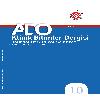Effect of the Pelleted Olive Cake on the Lamb Fattening Performance, Blood Parameters and Some Carcass Quality
Bu çalışmada, farklı düzeylerde zeytin küspesi içeren karma yemlerin kuzularda besi performansı kanparametreleri ve bazı karkas kalitesi üzerine etkileri araştırılmıştır. Denemede 27 adet 3-3.5 aylık erkek kuzularkullanılmıştır. Hayvanlar rastgele eşit sayıda gruba ayrılmıştır. Her hayvan bireysel bölmede barındırılmıştır.Gruplar; %0 (KYO), 12.5 (KY 12.5) ve 25 (KY25) düzeyinde zeytin küspesi içeren farklı karma yem verilmiştir.Her hayvan, karma yem ve içme suyunu ad libitum olarak tüketirken, kuru yonca otu 83.77 KM/hayvan/güntüketmişlerdir. Deneme 56 gün sürmüştür. Denemenin başında ve sonunda, tüm hayvanlardan kan örneklerialınmıştır. Tüm hayvanlar, denemenin sonunda kesilmiştir.Denemenin 0-56 günlük besi süresinde, hayvanların canlı ağırlık, canlı ağırlık artışı, kuru madde tüketimi veyemden yararlanma oranı, 2. dönem kuru madde tüketimi ve yemden yararlanma oranı hariç, gruplar arasındaistatistiksel olarak bir fark bulunmamıştır. Ancak, besinin 2. döneminde KY25 grubunda kuru madde tüketimi(yoğun yem ve rasyon/gün) aıtmış, yemden yararlanma oranı düşmüştür (P
PELETLENMİŞ ZEYTİN KÜSPESİNİN KUZU_BESİ PERFORMANSI, KAN PARAMETRELERI ve BAZI KARKAS KALITESİ ÜZERİNE ETKİSİ*
In this study, the effects of mixed feeds containing different levels of olive cake on fattening performance, blood parameters and some carcass quality in lambs were examined. In the experiment 3-3.5 months old 27 male lambs were used. Animals were divided into three groups randomly in equal numbers. Each animal was housed in individual section. Lambs consumed mixed feed containing olive cake at level of 0% (KYO), 12.5% (KY12.5) and 25% (KY25). While each animal consumed mixed feed and drinking water as ad libitum, alfalfa hay was consumed as 83.77 DM/animal/day. The experiment lasted for 56 days. At the beginning and end of the experiment, the blood samples were taken from all animals. All lambs were slaughtered at the end of the experiment. In the 0-56 day fattening period ofthe experiment, olive cake levels have no significant effect on the live weight, live weight gain, dry matter intake and feed conversion ratio among the groups except for the 2nd period, the dry matter intake and the feed conversion ratio. However, in the 2nd period of the experiment, the dry matter intake (concentrated feed and total ration) increased and the feed conversion ratio decreased in KY25 group (P
___
- AOAC (1997) Official Methods of Analysis (AOAC). Association of official analytical chemists.l6th ed. Washington, D.C.
- Abarghoei M, Rouzbehan Y, Alipour (2011) Nutritive value and silage characteristics whole and party stoned olive cakes treated with molasses. Journal of Agricultural Sci. and Tech., 13:709-716.
- Al-Jassim RAM, Awadeh FT, Abodabos (1997) Supplementary feeding value ofurea-treated olive cake when fed to growing Awasi lambs. Anim. Feed Sci. Tech., 64, 287--292.
- Capen CC, Rosol TJ (1989) Calcium-regulating hormone and disease of abnormal mineral (calcium, phosphorun, magnesium metabolism). Clinical Biochemistry of Domestic Anim., pp. 678-752.
- Chiofalo B, Liotta L, Zumbo A, Chiofalo (2004) Administration of olive cake for ewe feeding: effect on milk yield and composition. Small Rumin. Res. 55, 169--176.
- Christodoulou V, Bampidis VA, Robinson PH, lsrailides CJ, Giouzelyiannis A, Vlyssides (2007) Nutritional and net energy value of fermented olive wastes in rations of lactating ewes. Czech J. Anim. Sci., 52(12): 456-462.
- ilya l, Hanoğlu H, Canbolat Ö, Sucu (2006) Kurutulmuş pirinanın yem değeri ve kuzu besisinde kullanılma olanaklari üzerine araştırmalar. 2. Kuzuların besi performansı üzerine etkileri. Uludağ Üniversitesi Ziraat Fakültesi Dergisi, 20( ): 13-23.
- Hadjipanayiotou (1994) Laboratory evaluation of ensiled olive cake, tomato pulp and poultry litter. Livest. Res. Rural. Dev., 6: 9.
- Hadjipanayiotou (2000) The use of crude olive cake silage as small ruminant feed in Cyprus: review. Cahires Options Mediterraneennes, 52: 51--54.
- Kramer JW (1989) Enzyme of diagnostic importance. Clinical Biochemistry of Domestic Anim., pp. 338- 363.
- Lanzani A, Bondioli P, Folegatti L, edeli E, Bontempo V, Chiofalo V, Panichi G, Dell'Orto (1993) lmpiego di sanse di olive integrate nell'alimentazione della pecora da latte: effetti sulle produzioni quali-quantitative di latte (integrated olive husks applied to the sheep feeding: influences on the quali-quantitative production of milk). Riv. ltal. Sost. Grasse. 70:375--383.
- Mioö B, Pavic V, Vnucec 1, Prpic Z, Kostelic A, Susic (2007) Effect of olive cake on daily gain, carcass charactaristics and chemical composition of lamb meat. Czech J. Anim. Sci., 52(2): 31-36.
- Molina Alcaide E, Yanez Ruiz DR, Moumen A, Martin Garcia A1 (2003) Ruminal degradability and in Vitro intestinal digestibility of sunflower meal and in Vitro digestibility of olive by-products supplemented with urea or sunflower meal Comparison between goats and sheep.Anim. Feed Sci. Tech., 110, 3--15.
- Molina-Alcaide E, Martin-Garcia Al (2008) Effect of different drying procedures on the nutritive value of olive (Olea europaea var. europaea) leaves for ruminants. Anim. Feed Sci. Tech., 142:317--329.
- Morgan DE, Trinder (1980) The composition and nutritional value of some tropical and sub-tropical byproducts. Page 91 in By-products and Waste in Animal Feeding. Occas. Publ. 3, 1980. E. R. Plrskov, ed. Br. Soc. Anim. Prod, Reading, England.
- NRC (1985) Nutrient requirements of sheep. Sixth revised edition, National Academy Press., Washington, DC. Sansoucy (1985) Olive by-products for animal feed. FAO Animal Production and Health, paper: 43, ltaly.
- SPSS (1999) SPSS for windovs, Advanced Statistics Release 10. SPSS Inc., Chicago, USA. Tennant BC, Hombuckle WE (1989) Gastiointestinal function. Clinical Biochemistry of Domestic Anim., pp.4l7-46l.
- Van Soest PJ, Robertson JB, Lewis BA (1991) Method for dietary fiber, neutral detergent fiber, and non-starch polysaccharides in relation to animal nutrition. Journal ofDairy Sci., 74: 3583--3597.
- ISSN: 1304-7787
- Yayın Aralığı: Yılda 2 Sayı
- Başlangıç: 2004
- Yayıncı: Adnan Üniv. Ziraat Fak.
Sayıdaki Diğer Makaleler
SİMMENTAL YETİŞTİRİCİLİĞİNİN_DEĞERLENDİRILMESİ: 1. DÜNYADA ve TURKIYE'DEKI YETIŞTIRICILIGİ
TÜRKİYE'DE GIDA GÜVENCESİNİN MEVCUT DURUMUNUN DEĞERLENDİRİLMESİ
AYDIN İLİ YERALTI SULARININ HAYVANCILIK İÇİN İÇME SUYU KALİTESİ BAKIMINDAN DEGERLENDIRMESI
Ahmet Önder ÜSTÜNDAĞ, Mürsel ÖZDOĞAN, Huriye DEMİREL
Comparative Advantage of Turkey in Apple Exports
BİTKİ BÜYÜME DÜZENLEYİCİLERİNİN KULLANIMI VE İÇSEL HORMONLARIN BİYOSENTEZİNİ ARTTIRICI UYGULAMALAR
Burak Erdem ALGÜL, Gonca GÜNVER DALKILIÇ, Faik Ekmel EKİNTAŞ
TALİH GÜRBÜZ, HÜSEYİN BAŞAL, HATİCE KÜBRA GÖREN
